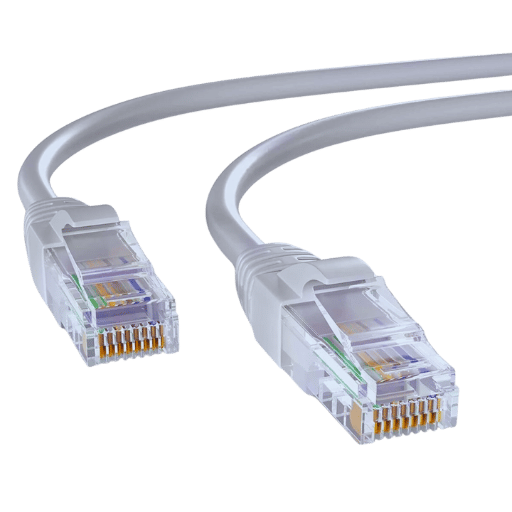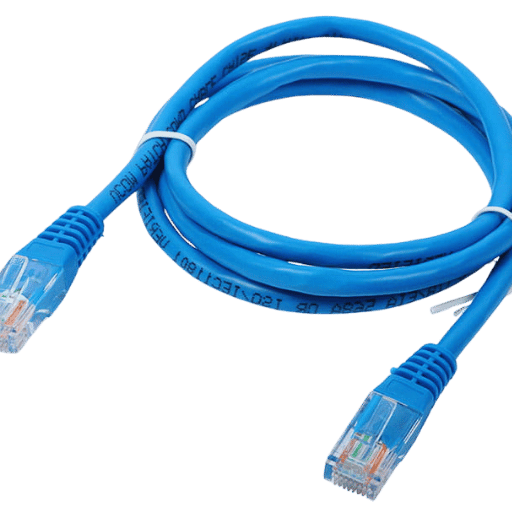Ethernet cables have become a fundamental instrument in both homes and workplaces as they facilitate the smooth operation of internet usage in this age of technological advancement. The purpose of this article concerning the above-mentioned topic is to inform the readers about the categories of Ethernet cables and other specifications in detail. Familiarizing oneself with the technicalities and differences of Ethernet cables will help the reader to purchase the right one for their needs. Along the same line, this will be an excellent guide to anyone, whether it is a computer geek, a business proprietor, or just interested in the functioning of the internet, to provide all the information and understanding about this topic.

An Ethernet cable is categorized as a network cable that allows users to connect various devices over a Local Area Network (LAN) through wired communication. It communicates through electrical data and follows the specific protocol set forth by the Institute of Electrical and Electronics Engineers (IEEE). Networking depends not only on the geographical classification of devices but also on the cabling that they utilize. Ethernet cables come in various categories, such as Category 5e, Category 6, and Category 6a. Each of them supports specific data transmission rates and overall data rates that can perform well for designated applications on a network.
It is critical to consider the various categories available at the time of selecting a category Ethernet cable since each has a purpose it serves in the transmission of data.
Comprehending the differences of these ethernet cable categories is important in choosing the best cable for your networking needs while assuring efficiency and reliability in transmission of data.
Just as it is rare and unwise to take the multichannel approach, it is also not recommended to sit on the fence when deciding to deploy either Unshielded Twisted Pair cables (UTP) or Shielded Foiled Twisted Pair cables (S/FTP) at restoration works or within a transmission site. Many considerations come into play and these are related more to the particular demands that are present in your networking environment.
However, the decision in the case of UTP vs S/FTP cables should depend on your particular operating conditions, the budget you are willing to spend, and the chance of interference from somewhere in your networking setup.

Before purchasing Ethernet cables, it is important to consider product specifications in order to avoid costly compatibility and performance issues associated with your particular networking scenario. The essential parameters include the category of the cable (like Cat5e, Cat6 or Cat6a), which dictates the highest possible figures in terms of data rate and bandwidth. Then, such parameters as length, type of shielding, and type of connectors can be of great importance with regard to the signal strength and vulnerability to interference. Almost all of these parameters are provided by manufacturers in their product specifications. Buyers can, therefore, ensure that their purchases meet their requirements in terms of operational ability and enhance the usability of the network. Every commercial option that involves equipment purchase usually comes with a wide range of specifications that need to be cross-checked before making the purchase.
The warranty policy can be described as the promise of the manufacturer or the seller to repair or replace a product for some time in cases where this product is of unsatisfactory quality or has defects. There may be a considerable difference with regard to many of the manufacturers and the specifics of the warranty given. Limited warranty, normal warranty, and full warranty are the commonly used types of warranty policies, and the latter provide full protection against any possible risks. In most cases, warranties would not cover risks attributed to poor usage or incorrect handling. With regard to the warranty details, however, to avoid misunderstanding when going to buy these products, it’s prudent for them to learn the details about the period of protection, the method of making a claim, and any limitations or exclusions that may be applicable. For all warranty changes or claims, please refer to the relevant policy that is found through the manufacturer’s warrant website or the product documentation.

A Cat6 Ethernet Cable has the ability to transmit data at 10 Gbps speed across a distance of 55 meters. It works on the frequency of 250 MHz and hence has lower crosstalk than the previous categories improving on signal quality. The Cat6 cables, because of its benefits, have usually a thicker wire gauge, thicker shielding and better insulation for more efficient operations within the network. They can also work with older Ethernet cables such as Cat5 and Cat5e, which makes them an effective solution for current networking requirements.
Several methods can be used to analyse fast Gigabit Ethernet cables and accurately classify them. First compare the category rating with the labels on the wires, wired with cat5e or cat6 is usually meant to connect a Gigabit patch. Cat5e can go up to a Giga bit per second of transmission with in the range of 100 meters, where as Cat6 can go as far as ten Giga bits per second but only, over the range of 55 meters, thus preferable in high end networks with Cat 6 cables.
Cable sheath markings are another important issue that, high-speed cables are stripped with specifications including CAT6 or CAT5e used with ieee 802.3ab standards. Examining the cross-section of the ethernet cable may also help in understanding how it behaves. Search for such indicators as thicker nature of the copper wiring enhancing its effectiveness by use of reverse AWG and use of twisted pairs with stronger shielding eg STP or S/FTP.
Lastly, a cable tester remains one of the pointed tools to test the performance of the cables within the network environment. A tester can determine the ability of a cable to transmit specific specifications and failure in the quality of signals that link the connections together with other issues related to speed functionalities.
Knowing the correct length of the Ethernet cable is essential for the proper functioning of networks. In general, particularly for high-speed connections, industries advise that the cable length is maintained as short as possible to achieve the respective conditions of the environment. The distance that can be measured for standard Ethernet applications, including Cat5e and Cat6 cables, does not exceed one hundred meters (328 feet). This is termed as the maximum running length of the Ethernet cable connections, and excess of this length means that some quality conservation will be lost, which will affect the speeds and the stability of the connection.
If you are thinking about your cable length, think about how your room is set up and how far away your networking hardware is. It is prudent to take into consideration the length of the actual distance required and make allowances for routing of the cable and other obstructions. Shorter cable runs are preferable in areas requiring very high performance, such as server rooms or data centers, mainly because they allow optimal data rate maintenance with no noise.

There are a few factors that one should keep in mind when reviewing seller ratings for Ethernet cables:
These factors will help make the best decision in the process of selecting an Ethernet cable.
By adoption of such features into their review policies, consumers would be able to tell apart trustworthy and unreliable reviews while improving their shopping habits.
Verified purchases stand as one of the most important indicators in the review system since they play the role of a shield against bias or any form of revisionism. A review that depicts a verified purchase tag attests to the fact that the reviewer actually purchased the item using the site, which provides some validity. As various reputable circles mentioned, such as industry professionals and consumer social services, verified reviews can be referred to as more objective because they tend to be concerned with firsthand experience and dedication to the product. More studies also support that products with a higher percentage of verified purchase reviews tend to have lower instances of return, which are signs of satisfied customers. In the end, the presence of or relying on verified purchases makes the decision-making process more accurate and, therefore, makes it more possible for consumers to shop for goods that genuinely satisfy their needs and expectations.

Assessing the brand bearers like Ugreen or other brands that produce Ethernet cables elicits a number of considerations. Well-known companies are able to afford strict examination and monitoring of the quality of their goods that answers certain parameters. Sometimes, this means a higher degree of effectiveness, longer product life, and better service rendering. Besides, assuming that the brands hold a certain level of reputation, there is a higher chance their specifications and product reviews will be reliable. Although basic or less famous brands can be priced low, such strategies do come at the expense of quality and performance. Therefore, where all the brand names do not encourage good performance, using popular and familiar brand names generally leads to better performance of the product.
It is necessary to use credible websites with all the listed products and price comparison features when one is doing a comparison of rates from different sellers. The following steps outline an effective method utilizing the advantages of the top three websites:
Purchasers thus become equipped in knowing how to clearly make the best decisions possible through the proper utilization of these tools and resources.
A: RJ45 is the common or usual connector fitted at the end of the Ethernet leads. It is an 8-pinete modular plug which explains why some people refer to ethernet cables as “8 ethernet cables”. The RJ45 connector makes it easier for networking devices to connect with each other.
A: Cat 6 (Category 6) is a type of twisted pair cable standard used by ethernet within the local area network. Cat 6 improves on earlier standards, allowing data transfer speeds of 10 Gbps at distances of up to 55 m. Cat 6 cables do have enhanced parameters, in particular for next-to housing crosstalk levels and nature of the system noise than ordinary Cat 5 and Cat 5e.
A: Even though Ethernet cables are mainly used on the network, those cannot be used in place of HDMI Cables meant for sound and or pictures. Nevertheless, smart televisions do come with Ethernet ports with which to connect to the internet. If you want to attach your device to a TV or monitor for displaying images, you will have to make use of HDMI cables or a suitable aiming cable.
A: The Ethernet cable length is recommended not to exceed 100 meters (328 feet). Beyond this distance, signal attenuation can come into play. If you need to take it beyond that distance, then you may want to think of getting an Ethernet extension cable or even a signal amplifier. Most home applications do not require cables longer than, say, 2m Ethernet cables are able to accommodate.
A: There are various variations of ethernet cables commonly categorized into different sorts this includes cat 5, cat 5e, cat 6, cat 6a and cat 7. Performance tends to rise in every sub category in terms of faster speed and less noise. At the moment Cat 6 and Cat 6a are among the most preferred ethernet cables for home and business utilization that require high-speed internet connectivity.
A: In this case, you need to consider your routing device’s Ethernet port capabilities and the Internet connection speed. Usually, a Cat 6 Ethernet cable is a good option as it provides good connectivity with a modern router and is backward compatible. Remember always to have RJ45 fitted connectors for the cable.
A: Regular or standard ethylene cables are meant for indoor use. Outdoor Ethernet cables should be used to install Ethernet cables outside. These include additional stress on moisture and ultraviolet sun rays plus high and low temperatures. If you need to run a cable outside the house, pick something that is specially designed for the outside world.